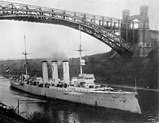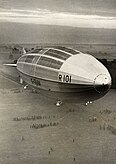From today's featured article Dresden in the Kaiser Wilhelm Canal SMS Dresden was a German light cruiser, armed with ten 10.5 cm (4.1 in) SK L/40 guns and two torpedo tubes, launched in October 1907. Dresden visited the United States in 1909 during the Hudson–Fulton Celebration, before serving in the High Seas Fleet. In 1913, she was assigned to the Mediterranean Division, then sent to the Caribbean. At the onset of World War I, Dresden operated as a commerce raider in South American waters in the Atlantic, then moved to the Pacific Ocean and joined the German East Asia Squadron. Dresden saw action in the Battle of Coronel in November 1914, and at the Battle of the Falkland Islands in December, where she was the only German warship to elude the British. In March 1915, when she was almost out of coal and her engines were worn out, her captain attempted to have the ship interned by Chile at Robinson Crusoe Island. British cruisers violated Chilean neutrality and opened fire on the ship in the Battle of Más a Tierra and the Germans scuttled Dresden. (Full article...)
Recently featured:
Did you know ...
|
In the news
On this day
|
From today's featured list
American actor Sigourney Weaver first began acting in plays in the early 1970s. Throughout her career, she has acted in nearly 40 stage productions. She made her film debut with a minor role in the Woody Allen–directed Annie Hall (1977). Her breakthrough role was as Ellen Ripley in the Ridley Scott–directed Alien (1979). She reprised the role in Aliens (1986), this time helmed by director James Cameron. Her performance netted her a nomination for the Academy Award for Best Actress. She would reprise the role in two more sequels: Alien 3 (1992) and Alien Resurrection (1997), both of which were not as well received. Although originally written as a man, Ripley is now regarded as one of the most significant female protagonists in cinema history, and consequently, Weaver is considered to be a pioneer of action heroines in science-fiction films. (Full list...)
Today's featured picture

|
The Tortoise Trainer is an oil-on-canvas painting created by the Turkish artist Osman Hamdi Bey between 1906 and 1907. It depicts a dervish contemplating several tortoises roaming the floor of an upper-storey room in what may be the Green Mosque in Bursa. He wears a skullcap wrapped round with a sash, and a long, red robe with embroidered border. In his left hand he holds a ney and on his back hangs a small kettledrum; he is attempting to train the animals with these musical instruments rather than by the use of force. In the painting, Hamdi satirises the slow and ineffective attempts at reform in the Ottoman Empire. The work is now located in the Pera Museum in Istanbul. Painting credit: Osman Hamdi Bey
Recently featured:
|
Other areas of Wikipedia
- Community portal – Bulletin board, projects, resources and activities covering a wide range of Wikipedia areas.
- Help desk – Ask questions about using Wikipedia.
- Local embassy – For Wikipedia-related communication in languages other than English.
- Reference desk – Serving as virtual librarians, Wikipedia volunteers tackle your questions on a wide range of subjects.
- Site news – Announcements, updates, articles and press releases on Wikipedia and the Wikimedia Foundation.
- Village pump – For discussions about Wikipedia itself, including areas for technical issues and policies.
Wikipedia's sister projects
Wikipedia is hosted by the Wikimedia Foundation, a non-profit organization that also hosts a range of other projects:
Free media repository
Wiki software development
Wikimedia project coordination
Free textbooks and manuals
Free knowledge base
Free-content news
Collection of quotations
Free-content library
Directory of species
Free learning resources
Free travel guide
Dictionary and thesaurus



